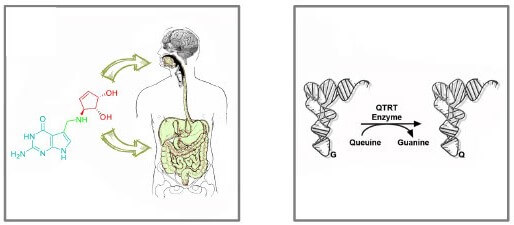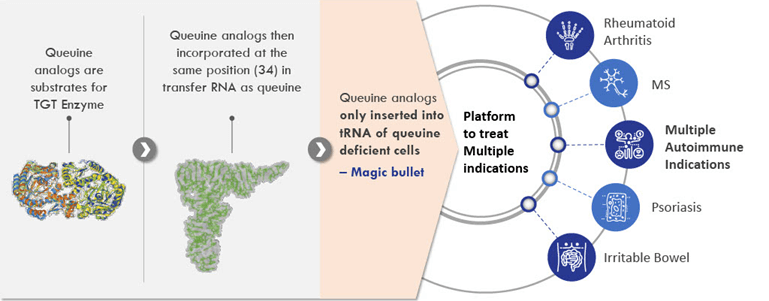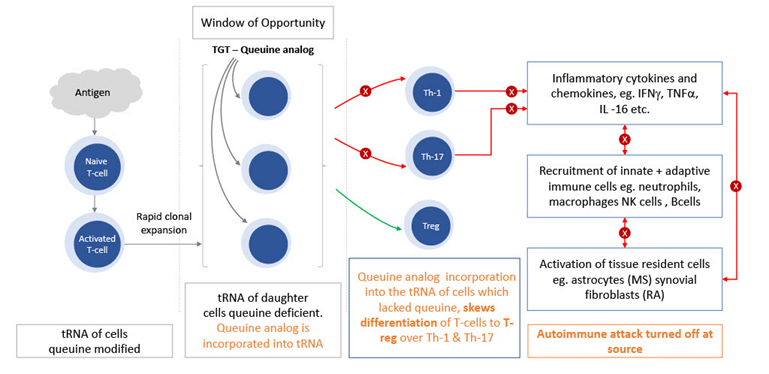Azadyne have identified a new target and previously undrugged pathway. Using this approach, Azadyne are able to exert epigenetic control over tRNA.
A key effect of this epigenetic control is the ability to influence the differentiation of T cells to a regulatory phenotype instead of an effector one.
This mode of action has application to a wide range of autoimmune conditions and the approach also has the potential to be a platform technology.
Azadyne’s research has focused on the exploitation of the queuine tRNA ribosyltransferase (QTRT) enzyme pathway (also known as TGT), characterised by the founders (Boland et al., 2009; Chen et al., 2010).

Queuine is a natural micronutrient that is produced exclusively by bacteria. Structurally, it has a 7- deazaguanine core (turquoise), an amino-methyl side chain (green) and a cyclopentenediol ring (red) shown below. Almost all eukaryotic organisms (mammals, algae, fungi, yeast, and plants) salvage queuine from bacteria. Humans obtain it from ingested food and the gut flora.
Following uptake into cells, queuine is incorporated into the anticodon loop of transfer RNA (tRNA) associated with the amino acids, tyrosine, histidine, aspartic acid and asparagine: referred to as GUN tRNAs; shown below. In an unusual reaction, the nuclear encoded guanine at position 34 of the anticodon loop is replaced by queuine. This reaction is carried out by the queuine tRNA ribosyltransferase (QTRT) enzyme; also referred to as TGT (tRNA- guanine transglycosylase) or QI (queuine insertase) (Alqasem et al., 2020). Almost all eukaryotes perform this reaction.

Under certain conditions such as the rapid clonal expansion of cells, tRNA in that cell is unmodified by queuine.
Azadyne have designed small molecule queuine analogs which are substrates for the QTRT enzyme and which can be selectively inserted into the unmodified tRNA of these cells.

The effect of Azadyne’s queuine analogs is to skew differentiation of T-cells into T-reg cells, instead of T-helper cells such as Th1 and Th-17. The effect of this is to turn off the autoimmune attack at source, preventing the inflammatory cascade. Further this mechanism appears not to suppress the body’s natural immune response.

We have demonstrated the ability of compounds acting via the queuine pathway to
- Be incorporated only into the queuine deficient tRNA
- To skew differentiation of T cells in vitro
- To skew differentiation of T cells in vivo
- To show efficacy in animal models of autoimmune diseases
- To show efficacy in human samples
- To show no suppression of the general immune response
- The pathway to be clean, targeted and safe in tox studies.
With Azadyne’s proprietary knowledge of the pathway we are able to provide compounds carefully designed and calibrated to induce effects within the cells.
Portfolio
MS-19-16 preclinical autoimmune
MS-19-17 preclinical autoimmune
Aza – B preclinical – other indication
